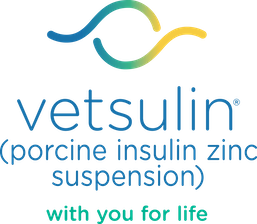

Glycated Protein Levels
Read More About Monitoring & Controlling Canine Diabetes
Serum Fructosamine and Glycosylated Hemoglobin
Serum fructosamine and glycosylated hemoglobin (HbA1c) are 2 glycated proteins commonly used for monitoring patients with diabetes. These 2 proteins are markers of mean glucose concentration and their amount is proportional to the blood glucose concentration. The concentration of these proteins is not affected by stress; therefore, they are ideal for monitoring stressed, dogs with diabetes.
Although serum fructosamine and HbA1c are good tools for determining regulation, they will not identify an underlying problem, nor will they replace glucose curves done for adjustments of therapy. Rather, they give an idea of the control of the glycemia for a long period: fructosamine reflects the glycemic control for the previous 2 to 4 weeks and HbA1c provides 110 days of canine average glucose levels.
Fructosamine
The majority of animals with diabetes will not always have optimal control of blood glucose, thus fructosamine concentrations are unlikely to lie entirely within the reference range for normal dogs. Single fructosamine measurements should be interpreted in the light of clinical signs of diabetes, body weight, and blood glucose concentration. In general, the closer the fructosamine concentration is to the reference range for healthy dogs, the better the glycemic control.
Fructosamine reference ranges8
| Dogs | Fructosamine values (μmol/L) |
|---|---|
| Normal dog without diabetes | 225–365 |
| Newly diagnosed dog | 320–850 |
| Treated dogs with diabetes: | |
| Excellent control | 350–400 |
| Good control | 400–450 |
| Fair control | 450–500 |
| Poor control | >500 |
Advantages of measuring fructosamine
- Distinguishes hyperglycemic, dogs without diabetes from diabetes with chronic hyperglycemia.
- Does not appear to be influenced by transient hyperglycemia.
- Useful in evaluating longer-term control and owner compliance with insulin treatment.
Limitations of fructosamine measurements
- Cannot distinguish between dysregulation and Somogyi effect.
- Unable to detect short-term or transient abnormalities in the blood glucose concentration, eg, transient daily episodes of hypoglycemia. This would require serial measurement of blood glucose concentrations.
- Albumin and fructosamine concentrations are highly correlated in dogs. Dogs with hypoalbuminemia also have a decreased fructosamine concentration (false negative)—the laboratory performing the analysis should be consulted as to whether a correction is required and whether or not this has been done.
Glycosylated Hemoglobin (HbA1c)
HbA1c is produced by the non-enzymatic, irreversible binding of glucose to hemoglobin in erythrocytes. The glycosylation of hemoglobin is a gradual process and is not affected by acute or transient hyperglycemia.
Glycosylated (glycated) hemoglobin concentration can be used as a screening test for diabetes mellitus, as well as for the monitoring of glycemic control in treated animals.
Advantages of HbA1c Measurements
- Unaffected by stress-related or postprandial hyperglycemia.
- Useful in long-term monitoring of dogs with diabetes over the previous 2–4 months.
Limitations of HbA1c Measurements
- Not the most effective test due to the relatively long erythrocyte lifespan (approximately 110 days in dogs).
- Less effective for short-term monitoring than fructosamine because hyperglycemia must be present for at least 3 weeks before increased values are detectable.
- Affected by hemoglobin concentrations: may be increased or decreased due to polycythemia or anemia, respectively.
Test results and interpretation vary greatly depending on the literature consulted and the laboratory where the test is performed. Therefore, it is recommended to ask each laboratory for the guidelines for the purposes of interpretation.
To submit blood samples to the lab, tubes for serum (red-top tubes) must be used for fructosamine; and tubes for whole blood (EDTA tubes, lavender-top tubes) for HbA1c. A new dried blood spot, mail in test is available for testing HbA1c in dogs as well.
Suggested Additional Reading
- Feldman EC, Nelson RW. Canine and Feline Endocrinology and Reproduction.3rd ed. St. Louis, MO: Saunders; 2004.
Resources to Help Clients Monitor Care
Help Your Practice Manage Diabetes Mellitus
View and download resources and tools that will assist your hospital, inform your team, and help with clients.

Blood Glucose Curve Generator
Create a blood glucose curve to monitor and evaluate diabetes treatments.

Client Discharge Form
Create a customized, printable form for clients about their new diagnosis.

Diabetes Resources
Access online tools and more to support staff and pet parents.
No items to show.
Read More About Monitoring &Controlling Canine Diabetes
Important Safety Information:
Vetsulin® should not be used in dogs known to have a systemic allergy to pork or pork products. Vetsulin is contraindicated during periods of hypoglycemia. Keep out of reach of children. As with all insulin products, careful patient monitoring for hypoglycemia and hyperglycemia is essential to attain and maintain adequate glycemic control and prevent associated complications. Overdosage can result in profound hypoglycemia and death. The safety and effectiveness of Vetsulin in puppies, breeding, pregnant, and lactating dogs has not been evaluated. See package insert for full information regarding contraindications, warnings, and precautions.
References:
1. Martin GJ, Rand JS. Pharmacology of a 40 IU/ml porcine lente insulin preparation in diabetic cats: findings during the first week and after 5 or 9 weeks of therapy. J Feline Med Surg. 2001;3(1):23–30. 2. Vetsulin® (porcine insulin zinc suspension) [Freedom of Information Summary]. Millsboro, DE: Intervet Inc.; 2008. 3. Data on file, Merck Animal Health. 4. Graham PA, Nash AS, McKellar QA. Pharmacokinetics of porcine insulin zinc suspension in diabetic dogs. J Small Anim Pract. 1997;38(10):434–438. 5. Martin GJ, Rand JS. Pharmacokinetic and Pharmacodynamic Study of Caninsulin in Cats with Diabetes Mellitus. 2000: Internal Study Report. 6. Feldman EC, Nelson RW. Canine and Feline Endocrinology and Reproduction. 3rd ed. St. Louis, MO: Saunders; 2004:539–579. 7. Tennant B, ed. BSAVA Small Animal Formulary. 4th ed. Gloucestershire, UK: British Small Animal Veterinary Association; 2002. 8. Feldman EC, Nelson RW. Canine and Feline Endocrinology and Reproduction. 3rd ed. St. Louis, MO: Saunders; 2004:486–538. 9. Reusch C. Feline diabetes mellitus. In: Ettinger SJ, Feldman EC, eds. Textbook of Veterinary Internal Medicine. 7th ed. St. Louis, MO: Saunders; 2010:1796–1816. 10. Nelson RW. Canine diabetes mellitus. In: Ettinger SJ, Feldman EC, eds. Textbook of Veterinary Internal Medicine. 7th ed. St. Louis, MO: Saunders; 2010:1782–1796. 11. Burgaud S, Riant S, Piau N. Comparative laboratory evaluation of dose delivery using a veterinary insulin pen. In: Proceedings of the WSAVA/FECAVA/BSAVA congress; 12–15 April 2012; Birmingham, UK. Abstract 121. 12. Burgaud S, Guillot R, Harnois-Milon G. Clinical evaluation of a veterinary insulin pen in diabetic dogs. In: Proceedings of the WSAVA/ FECAVA/BSAVA congress; 12–15 April 2012; Birmingham, UK. Abstract 122. 13. Burgaud S, Guillot R, Harnois-Milon G. Clinical evaluation of a veterinary insulin pen in diabetic cats. In: Proceedings of the WSAVA/FECAVA/BSAVA congress; 12–15 April 2012; Birmingham, UK. Abstract 45. 14. Davison LJ, Walding B, Herrtage ME, Catchpole B. Anti-insulin antibodies in diabetic dogs before and after treatment with different insulin preparations. J Vet Intern Med. 2008;22:1317-1325. 15. Banfield State of Pet Health 2016 Report. p 12-13.
